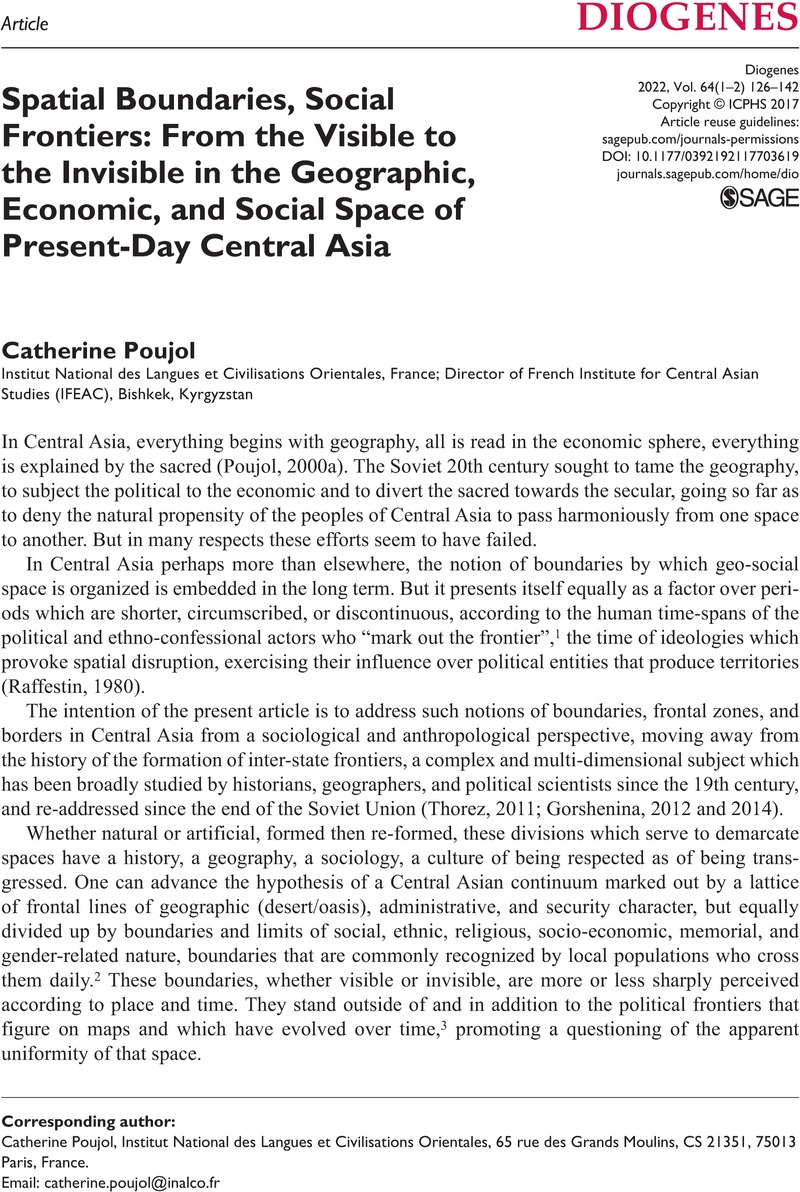No CrossRef data available.
Article contents
Spatial Boundaries, Social Frontiers: From the Visible to the Invisible in the Geographic, Economic, and Social Space of Present-Day Central Asia
Published online by Cambridge University Press: 01 January 2024
Abstract
An abstract is not available for this content so a preview has been provided. Please use the Get access link above for information on how to access this content.

- Type
- Articles
- Information
- Copyright
- Copyright © ICPHS 2017
References
Aouelbekov, S (2014) Découpage de l’espace et normes de comportement chez les Kazakhs, Cahiers d’Asie centrale, 23: 41–72, asiecentrale.revues.org/2541.Google Scholar
Aubin, F (1970) Les mesures manuelles et par référence au corps chez les Mongols. Notes de folklore juridique. In Ligeti, L (ed.) Mongolian Studies, pp. 23–55. Budapest: Akadémiai Kiadó.Google Scholar
Buttino, M (2009) Minorities in Samarkand: A case study of the city's Koreans, Nationalities Papers, 37(5): 719–742.CrossRefGoogle Scholar
Dadabaev, T (2013) Community life, memory and a changing nature of Mahalla identity in Uzbekistan, Journal of Eurasian Studies, 4(2): 181–196.CrossRefGoogle Scholar
Ferret, C (2014) Discontinuités spatiales et pastoralisme nomade en Asie intérieure au tournant des xixe et xxe siècles, Annales. Histoire, Sciences sociales, 69: 957–996.CrossRefGoogle Scholar
Fourniau, V (1991) Les Arabes d’Asie centrale soviétique: maintenance et mutation de l’identité ethnique, Revue du monde musulman et de la Méditerranée, 59–60: 83–100.CrossRefGoogle Scholar
Gorshenina, S (2012) Asie centrale: l’invention des frontières et l’héritage russo-soviétique. Paris: CNRS.Google Scholar
Gorshenina, S (2014) L’Invention de l’Asie centrale. Histoire du concept de la Tartarie à l’Eurasie. Geneva: Droz.Google Scholar
Kul’teleev, TM, Masevich, MG, Shakaev, GB (eds) (1998) Материалы по казахскому обычному праву. Almaty: Жалын баспасы.Google Scholar
Makoveckij, PE (1886) Материалы для изучения юридических обычаев киргизов, 1: Материальное право. Omsk: Семипалатинский областной статистический комитет.Google Scholar
Meyendorff, G de (1826) Voyage d’Orenbourg à Boukhara fait en 1820, à travers les steppes qui s’étendent à l’est de la Mer d’Aral et au-delà de l’ancien Jaxartes. Paris: Librairie orientale Dondey-Dupré père et fils.Google Scholar
Minorsky, V (1934) Tūrân. In The Encyclopædia of Islam, t. IV, pp. 878–879. Leyden: Brill.Google Scholar
Narchakhi, M (1892) Description topographique et historique de Boukhara: suivie de textes relatifs à la Transoxiane, traduite par Charles Scheffer. Paris: Leroux.Google Scholar
Nazarov, F (1821) Записки о некоторых народах и землях Средней части Азии. Saint-Petersburg: Печатано при Императорской Академии наук.Google Scholar
Ohayon, I (2006) La Sédentarisation des Kazakhs dans l’URSS de Staline. Paris: Maisonneuve & Larose.Google Scholar
Poujol, C (1984) Les esclaves russes à Boukhara et à Khiva du XVIe au XIXe siècle, Slovo, 5: 55–77.Google Scholar
Poujol, C (1989) La construction du chemin de fer transcaspien au Turkestan de 1880 à 1917: reflet des mentalités et consequences. In Innovations technologiques et mentalités, pp. 187–206. Paris: CNRS.Google Scholar
Poujol, C (1992) Boukhara, Khiva, Kokand et la Russie de 1700 à 1840 : le contact précolonial à travers l’expérience russe du voyage, PhD in Eastern history, University of Paris-III-Sorbonne-Nouvelle.Google Scholar
Poujol, C (2000a) Géographie sacrée de l’Asie centrale. In Balland, D (ed.) Hommes et Terres d’Islam. Mélanges offerts à Xavier de Planhol, I, pp. 449–469. Téhéran/Paris: IFRI.Google Scholar
Poujol, C (2007) Yourte. In L’Espace anthropologique. Cahiers de la recherche architecturale et urbaine 20–21, pp. 176–180. Paris: Éditions du patrimoine.Google Scholar
Poujol, C, ed. (2014) Le Kazakhstan en mutation. Les steppes kazakhes entre colonisation et soviétisation (1800–1920), Cahiers d’Asie centrale, 23.Google Scholar
Poujol, C (forthcoming) Architecture and politics in Central Asia: The mirage of the President. Subliminal planification and architecture in the new capital Astana (Kazakhstan). In Bissenova, A, Schoeberlein, J, McGuire, G (eds) The Steppe and the Sown, XIII Biennial Conference of the European Society for Central Asian Studies (ESCAS), Astana, Kazakhstan.Google Scholar
Remacle, X (1997) Comprendre la culture arabo-musulmane. Brussels: Centre bruxellois d’action interculturelle/Lyon: Chronique sociale.Google Scholar
Stepanoff, C, Ferret, C, Lacaze, G, Thorez, J (2013) Nomadismes d’Asie central et septentrionale. Paris: Armand Colin.Google Scholar
Sukhareva, OA (1966) Бухара xix – начало хх вв (Позднефеодальный город и его население). Moscow: Наука.Google ScholarPubMed
Sukhareva, OA (1976) Квартальная община позднефеодального городаБухары (в связи с историей кварталов). Moscow: Наука.Google ScholarPubMed
Thorez, J (2011) Les nouvelles frontières de l’Asie centrale : États, nations et régions en recomposition, Cybergeo: European Journal of Geography, cybergeo.revues.org/23707.Google Scholar
Tolybekov, SE (1971) Кочевое общество казахов в xvii – начале xx века. Политико-экономический анализ. Alma-Ata: Наука.Google Scholar
Zagrâžskij, GS (1876) Юридические обычаи киргиз и о народном суде у кочевого населения Туркестанского края по обычному праву. In Maev, NA (ed.) Материалы для статистики Туркестанского края, 4, pp. 151–202. Saint-Petersburg.Google Scholar


